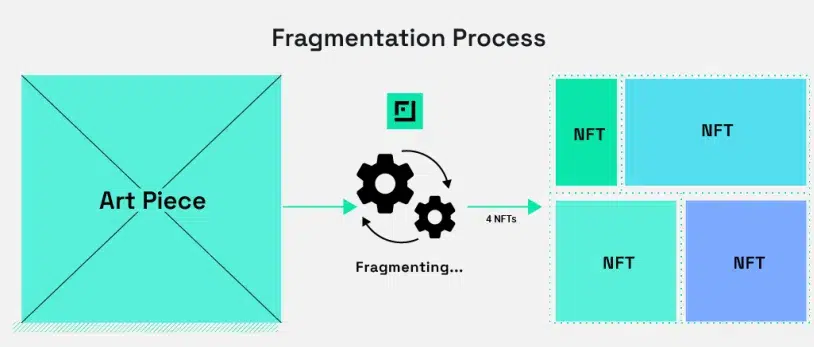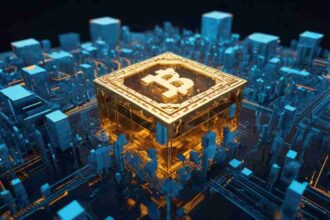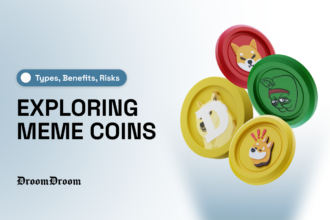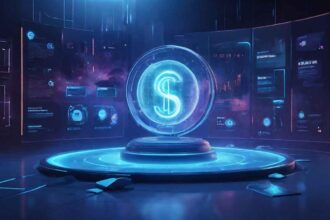NFT fragmentation is yet another revolutionizing concept in the world of digital assets. And it is gaining traction because it offers a new way to handle non-fungible tokens (NFTs), especially known for their distinctive property of non-divisibility. In this article, we dive into the details of NFT fragmentation, its significance, and we try to put the pieces back together…
NFT fragmentation, a process that divides non-fungible tokens into several pieces, has more than the potential to influence the broader NFT market and provide everyone an equal chance to participate in investing, owning and generating cash flow for digital art on the blockchain.
What Is NFT Fragmentation?
NFT fragmentation, as the name suggests, relates to the division or fragmentation of non-fungible tokens (NFTs) into multiple pieces i.e. tokens.
To understand this better, let’s take a look at an analogy.
Imagine a diamond shop owner who possesses an extraordinarily rare and valuable diamond. Due to its one-of-a-kind nature, the asking price for this gem is astronomical – far beyond what most diamond lovers could afford.
Seeking to expand the market for his prized possession, the clever shopkeeper devises a plan. He decides to have the stone carefully cut into multiple smaller diamonds that can be sold individually at more accessible prices. Though reduced in size, each fragment retains a touch of the original diamond’s singular brilliance.
Using specialized tools, the flawless gem is meticulously divided into shards of varying carats. The shopkeeper is now able to cater to buyers at all budget levels, from elite collectors seeking a substantial showcase piece to an average gem that enthusiasts are longing for.

In short, this is what we mean by NFT fragmentation, which is no more than dividing a unique, (mostly expensive) NFT into smaller NFTs, that each have their value. This fragmentation will not be done by diamond-cutting tools but is completely done through protocols, using smart contracts, which can split NFTs (based on the ERC-721 standard) into ERC-20 tokens.
Benefits of NFT Fragmentation
There are some key benefits of NFT fragmentation that we will discuss below;
Liquidity
The first and foremost reason for the evolution of NFT fragmentation is or was the lack of liquidity in the NFT markets. We see that high prices for popular NFT collections often create lots of barriers for interested buyers.
The big renowned NFT collections are not cheap, to say the least, and come with high price tags, making them inaccessible for regular investors and casual ‘NFT enjoyoors’.
Now with fragmentation, the poor retail investors can own a share of the highly valued NFTs. By doing this, secondary markets are created and new ways to attract liquidity for illiquid NFT markets are found. This enables sellers to sell their assets, although bits of them, and buyers to purchase them at lower and affordable prices.
To understand how to navigate the NFT marketplace like a professional, read our detailed tutorial.
But this might backfire as a fragmented market, where different platforms display different prices for the same asset at the same time could mean traders might struggle to get the best price for their fragment.
Generating Cash Flow
NFT fragmentation offers NFT creators and artists a new adaptable alternative for tokenizing a portion of their work and starting earning while still crafting their final collections. It is a form of funding where some can generate cash flow or income without selling their entire project. For fans, this can be a new way to fund their favorite artist and join their works by owning them.
Secondly, NFT fragmentation offers creators and artists a flexible new option for generating income from projects that are still in progress. By tokenizing and selling partial stakes in their unfinished collections, artists can access funding to sustain their work.
Fans and collectors also benefit from the chance to support beloved artists through fractional ownership. Instead of waiting for the full collection to be completed, enthusiasts can purchase individual NFT shards and participate in their creative journey.
Investment Funds
Lastly, NFT fragmentation has implications beyond the world of art. We can consider a fraction of an NFT representing partial ownership in an organization such as an asset investment fund, where the tokenized fragment now represents shared rights to the fund’s offerings – from yields to governance.
While the organization itself remains exclusive, whether it is equity in a startup or access to exclusive real estate or events, its buyers can own and exchange tiny slivers rather than have an all-or-nothing interest.
What are Some Examples of NFT Fragmentation?
Unic.Ly
Unic.ly allows users to construct a vault for one or more NFTs from the same collection and split them into different fungible ERC-20 tokens.
Fractional
Fractional is known for its user experience and solution design. It allows users to fragment their NFTs and create corresponding ERC-20 tokens. However, users must use third-party platforms such as Uniswap and SushiSwap to create a liquidity pool of fragmented tokens.
Szns.Io
SZNS Labs offers a product called SZNS, targeting NFT collectors and traders. SZNS allows users to fractionalize their NFT collections, transforming them into tradeable tokens. This enables users to share ownership and govern their collections together.
Bridgesplit
Bridgesplit provides asset-based financing solutions to platforms, allowing them to offer affordable and flexible financing options to their customers. It uses the Solana blockchain and offers a wide range of NFT-related products, including index funds, and yield farming with fragmented NFTs.
Fragment
Fragment is a unique platform that is revolutionizing the world of digital art by fragmentalizing NFTs in a more meaningful way. Unlike many projects that simply create cubic fractionalizations of tokens with not much value, Fragment focuses on breaking down NFTs into fewer parts but with stronger value.
The Future of NFT Fragmentation
Currently, the NFT fragmentation has a few use cases and with this, it will not stop. The potential benefits are known and the attraction of liquidity in the market, suggests a bright future for the NFT market as a whole.
However, the process of separating and dispersing assets is not without its challenges. Not all NFT projects are suitable for fragmentation, and those that are may face regulatory issues. Maybe some fragmented NFTs will be categorized as “unregistered securities” by certain regulators…(cough U.S.A.). If this were the case it could have its implications. So it is not all clear blue sky ahead.
Conclusion
NFT fragmentation is comparable to the cryptocurrency revolution, a relatively new concept that still is in its baby, baby shoes. While it may present new challenges, it also offers current potential solutions for the drying up of liquidity in the NFT market.
We can fairly say that as more and more people become interested in NFTs, the demand for fragmentation may grow. It will present promising opportunities most definitely.




















